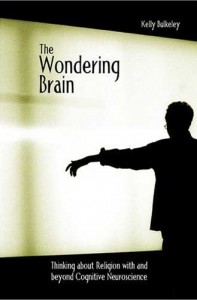 The Wondering Brain: Thinking About Religion With and Beyond Cognitive Neuroscience
The Wondering Brain: Thinking About Religion With and Beyond Cognitive Neuroscience
By Kelly Bulkeley
Routledge, 2004
Purchase this Book – Hardcover
Purchase this Book – Paperback
This book offers a new integration of religious thought and cognitive neuroscience. By focusing on experiences of wonder—startling encounters with the true, real, and/or beautiful—the author shows that human religiosity (and indeed all creative experience) depends on unexpected moments of radical decentering in which ordinary brain-mind systems are profoundly transformed, generating what science calls new consciousness and what religions call divine revelation.
The Wondering Brain explores four different spheres of wonder: dreams, sexual desire, art, and contemplative practice. Each chapter begins with a narrative of an individual life in which one of these spheres of wonder appears in especially vibrant form. The details of that narrative are then discussed in relation to the revolutionary findings of cognitive neuroscience (CN), which shed new light on the physiological roots of wonder in the human brain. CN can only take us so far, however, and this is where the resources of religious studies (RS) are brought into play, to provide historical and cultural context, to question the metaphysical assumptions of CN, and to clarify the inspiring, life-changing impact of experiences of wonder. Each chapter ends by returning to the original narrative with a richer appreciation for the dynamic interplay of brain-mind functioning and the religious imagination. Guided by the pioneering 20th century investigations of Freud, Jung, and James but pushing far beyond them, The Wondering Brain provides a new foundation for the study of religion and psychology in the 21st century. The book also issues a provocative challenge to scholars and general readers alike to think more deeply about the most dangerous of all spheres of wonder—the violent wonder of war.
Blurbs and Reviews
“A genuinely revelatory read in both the religious and intellectual senses of that term. The reductionist can only come away with a deeper appreciation for the innate or “hard-wired” religiosity of the human brain, and the religionist can only stand in awe before how much we really do know about the brain and its predictable workings. The wisest read, though, is perhaps the one that insists on balancing both of these polarized perspectives within a deep and playful sense of human wonder. Personally speaking, I have not stopped thinking and talking about this text since I set it down, and that was five months ago.”
— Jeffrey J. Kripal, J. Newton Rayzor Professor and Chair of Religious Studies, Rice University
“Kelly Bulkeley’s latest book, “The Wondering Brain” empowers both the scientific and the religious points of view. In his warm and humorous style the reader is informed of recent developments in brain science and religious thinking. I highly recommend this unique book to anyone interested in opening him or herself up to the wonders of the brain.”
— David Kahn, Department of Psychiatry, Harvard Medical School
Table of Contents
Introduction
1. Dreams and Visions
2. Sexual Desire
3. Creative Madness
4. Contemplative Practice
Conclusion: The Evolution of Wonder

 Soul, Psyche, Brain: New Directions in the Study of Religion and Brain-Mind Science
Soul, Psyche, Brain: New Directions in the Study of Religion and Brain-Mind Science Spiritual Dreaming: A Cross-Cultural and Historical Journey.
Spiritual Dreaming: A Cross-Cultural and Historical Journey.  Dreamcatching : Every Parent’s Guide to Exploring and Understanding Children’s Dreams and Nightmares.
Dreamcatching : Every Parent’s Guide to Exploring and Understanding Children’s Dreams and Nightmares. Dreams: A Reader on Religious, Cultural, and Psychological Dimensions of Dreaming.
Dreams: A Reader on Religious, Cultural, and Psychological Dimensions of Dreaming. The Wilderness of Dreams: Exploring the Religious Meanings of Dreams in Modern Western Culture.
The Wilderness of Dreams: Exploring the Religious Meanings of Dreams in Modern Western Culture.